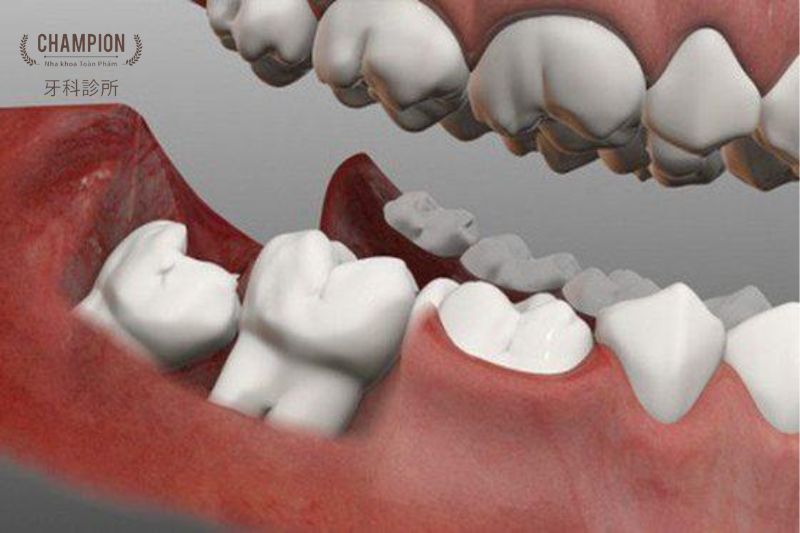Extraction is a necessary dental procedure in cases where the tooth cannot be restored or treated with other methods such as fillings or cracks. Here are some cases when tooth extraction is needed.
When do teeth need to be extracted?
Teeth need to be extracted in the following cases:
- Cavities and severely damaged teeth: Sometimes, teeth that are decayed, infected, or severely damaged cannot be treated with root canals or radiographs and require removal.
- Teeth in the wrong position: If teeth are not upright and cause inconvenience, sometimes, extraction is the only way to solve the problem.
- Increased positioning: In some cases, teeth interfere with speech or eating because they press on other teeth and create hyperposition.
- Slowing down dental progress: If one tooth slows down another dental process such as orthodontics, extraction may be the optimal solution.

However, tooth extraction is an important decision and should be made after discussing it with your doctor and conducting tests to make sure the tooth is being removed properly and safely.
What to do after tooth extraction?
After tooth extraction, you need to do the following things to ensure health and reduce pain:
- Rest and avoid strenuous activity: Rest for 24 hours after tooth extraction is recommended to reduce pain and the risk of bleeding.
- Use an anti-pain cream before impact: You can use an anti-pain cream to relieve pain and reduce swelling after tooth extraction.
- Keep the mouth area clean: Clean your teeth by brushing gently in the area around the wound but about 24 hours away from the bleeding area.
- Alkalize the blood: After tooth extraction, keep the cotton ball clean and dry until the bleeding stops completely.
- Limit your intake of food: Stop eating hot, hard foods, and carbonated drinks for the first 24 hours to avoid injury, bleeding, and pain.
- Drink plenty of water: Drink plenty of water to help reduce swelling and aid in the recovery process.
- Treating an infection: If you notice symptoms of an infection such as pain, swelling, or fever, consult your doctor for prompt treatment.
- Note: If pain or swelling persists or the pain becomes worse, consult your doctor immediately.

Teeth extraction method at Champion dental clinic
At Champion dental, the extraction methods used depend on the specific case of each patient and are performed by experienced professionals. Here are some commonly used tooth extraction methods at Champion dental:
- Simple tooth extraction: This is a simple and quick method of tooth extraction, often used for cases where teeth are loose or damaged.
- Complex tooth extraction: This method is used when the tooth is trapped or when there are many roots or when the tooth has broken and needs to be separated.
- Extraction of misaligned teeth: This method is used when teeth are misaligned or entangled and need to be moved to the correct position.
- Extraction of an ingrown tooth: This method is used when an ingrown tooth is causing problems with the teeth and gums.
Before deciding which method of tooth extraction to use, the doctor will perform a thorough dental examination to come up with a plan suitable for the patient's tooth condition.
Tooth extraction time at Champion dental clinic
The time taken to extract a tooth at Champion dental clinic depends on the condition of the tooth and the extraction method used. Usually, the extraction process will be carried out quickly and efficiently with advanced techniques and technologies, minimizing time and pain for the patient. Detailed information about tooth extraction time will be provided by Champion dentist when examining and advising patients.

Before tooth extraction
Before having a tooth extracted, you need to follow the instructions from your dentist, including:
- If you use anticoagulants, such as aspirin or ibuprofen, tell your dentist to avoid the risk of heavy bleeding after tooth extraction.
- If you are afraid of pain, you can ask your dentist to use a numbing medicine before the extraction.
After tooth extraction
After tooth extraction, you need to follow these guidelines to reduce pain and risk of infection:
- Use ice to soothe the painful area and reduce swelling.
- Avoid eating hot, spicy, hard or granular foods for the first 24 hours after tooth extraction.
- Leave the wound open for about 30 minutes to help the blood clot and prevent bleeding.
- Take medication as directed by your dentist to reduce pain and the risk of infection.
>> See more: Summary of the best orthodontic methods
Should you go with a loved one when having a tooth extracted?
Accompanying a loved one when a tooth is extracted is subject to the patient's comfort and need for support. If the patient feels comfortable and confident in the treatment, there is no need to be accompanied by a loved one. However, if the patient is worried or afraid of pain, having a family member will help and comfort the patient during treatment. In addition, relatives can also help patients with transportation and care after tooth extraction.
Vietnamese & English: (028) 5411-2295
中文: (028) 5411-2297 172 Nguyen Luong Bang, Tan Phu Ward, District 7, Ho Chi Minh City.
Fanpage: Champion Dental Clinic 牙科診所
Zalo: Champion Dental Clinic
Youtube: Champion Dental Clinic 牙科診所
 Champion Dental Clinic
Champion Dental Clinic



